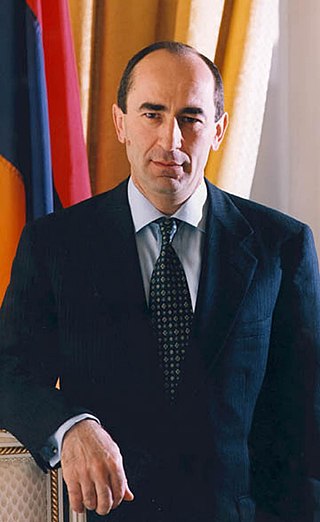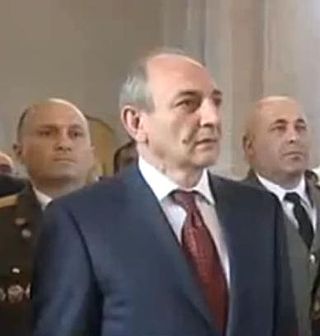
Nagorno-Karabakh is a region in Azerbaijan, covering the southeastern stretch of the Lesser Caucasus mountain range. Part of the greater region of Karabakh, it spans the area between Lower Karabakh and Syunik. Its terrain mostly consists of mountains and forestland.

Robert Sedraki Kocharyan is an Armenian politician. He served as the President of the Nagorno-Karabakh Republic from 1994 to 1997 and Prime Minister of Nagorno-Karabakh from 1992 to 1994. He served as the second President of Armenia between 1998 and 2008 and as Prime Minister of Armenia from 1997 to 1998.

Artsakh, officially the Republic of Artsakh or the Republic of Nagorno-Karabakh, was a breakaway state in the South Caucasus whose territory was internationally recognised as part of Azerbaijan. Between 1991 and 2023, Artsakh controlled parts of the former Nagorno-Karabakh Autonomous Oblast of the Azerbaijani Soviet Socialist Republic, including its capital Stepanakert. It had been an enclave within Azerbaijan from the 2020 Nagorno-Karabakh war until the 2023 Azerbaijani offensive, when the Azerbaijani military took control over the remaining territory controlled by Artsakh. Its only overland access route to Armenia after the 2020 war was via the 5 km (3.1 mi) wide Lachin corridor, which was placed under the supervision of Russian peacekeeping forces.

The First Nagorno-Karabakh War was an ethnic and territorial conflict that took place from February 1988 to May 1994, in the enclave of Nagorno-Karabakh in southwestern Azerbaijan, between the majority ethnic Armenians of Nagorno-Karabakh backed by Armenia, and the Republic of Azerbaijan with support from Turkey. As the war progressed, Armenia and Azerbaijan, both former Soviet republics, entangled themselves in protracted, undeclared mountain warfare in the mountainous heights of Karabakh as Azerbaijan attempted to curb the secessionist movement in Nagorno-Karabakh.

The Nagorno-Karabakh conflict was an ethnic and territorial conflict between Armenia and Azerbaijan over the region of Nagorno-Karabakh, inhabited mostly by ethnic Armenians until 2023, and seven surrounding districts, inhabited mostly by Azerbaijanis until their expulsion during the 1990s. The Nagorno-Karabakh region was entirely claimed by and partially controlled by the breakaway Republic of Artsakh, but was recognized internationally as part of Azerbaijan. Azerbaijan gradually re-established control over Nagorno-Karabakh region and the seven surrounding districts.

The Republic of Artsakh was a republic with limited recognition in the South Caucasus region. The Republic of Artsakh controlled most of the territory of the former Nagorno-Karabakh Autonomous Oblast. It was recognized only by three other non-UN member states, Abkhazia, South Ossetia and Transnistria. The rest of the international community recognized Artsakh as part of Azerbaijan. In November 2012, a member of Uruguay's foreign relations committee stated that his country could recognize Nagorno-Karabakh's independence. In 2012, Armenia and Tuvalu established diplomatic relations, which led to speculation of possible recognition of Artsakh by Tuvalu. In October 2012, the Australian state of New South Wales recognized Nagorno-Karabakh. In September 2014, the Basque Parliament in Spain adopted a motion supporting Artsakh's right to self-determination and in November 2014, the Parliament of Navarre, also in Spain, issued a statement supporting Artsakh's inclusion in taking part in settlement negotiations.
Operation Ring, known in Azerbaijan as Operation Chaykand was the codename for the May 1991 military operation conducted by the Soviet Army, Internal Troops of the Ministry of Internal Affairs (MVD) of the USSR and OMON units of the Azerbaijan SSR in the Khanlar and Shahumyan districts of the Azerbaijani SSR, the Shusha, Martakert and Hadrut districts of the Nagorno-Karabakh Autonomous Oblast, and along the eastern border of the Armenian SSR in the districts of Goris, Noyemberyan, Ijevan and Shamshadin. Officially dubbed a "passport checking operation," the ostensible goal of the operation was to disarm "illegal armed formations" in and around Nagorno-Karabakh, referring to irregular Armenian military detachments that had been operating in the area. The operation involved the use of ground troops accompanied by a complement of military vehicles, artillery and helicopter gunships to be used to root out the self-described Armenian fedayeen.

A constitutional referendum was held in the unrecognised republic of Nagorno-Karabakh on 10 December 2006 to approve a draft constitution, which defined Nagorno-Karabakh as a sovereign state. Azerbaijan condemned the referendum, saying it is an unconstitutional attempt to damage the peace process.
The military history of the Republic of Artsakh contains information about the history of military actions or events performed by or in the Republic of Artsakh.

The following outline is provided as an overview and topical guide of the Republic of Artsakh and Nagorno-Karabakh region:
Settlement near Sovkhoz No. 2 of Garsharabtrest is a former settlement in the Khojaly Urban administrative district of Khojaly District of Azerbaijan. After Azerbaijan restored its independence, sovkhozes there were liquidated. Currently, the name of this locality is not included in the Urban administrative district of the town of Khojaly and in general the entire Khojaly region. From the beginning of the 90s of the twentieth century to 2023, it was controlled by the unrecognized Nagorno-Karabakh Republic (NKR) and, according to the administrative-territorial division of the Nagorno-Karabakh Republic, was part of the Askeran region of the NKR and was called the village of Berkadzor.

Hadrut is a town in the Khojavend District of Azerbaijan, in the region of Nagorno-Karabakh.

Parliamentary elections were held in the Nagorno-Karabakh Republic on 23 May 2010.

The Constitution of the Republic of Artsakh was the basic law of the Republic of Artsakh. It was approved by the people of Artsakh in a referendum that was held on 20 February 2017. It superseded the constitution previously ratified by the people in 2006. Over 76.5% of the electorate participated in the 2017 referendum. Of these, over 90% voted for its adoption with just under 10% voting against its adoption. This constitution proclaimed the Nagorno-Karabakh Republic to be a sovereign, democratic state that was based on social justice and the rule of law. The constitution stated that the names "Republic of Artsakh" and "Republic of Nagorno-Karabakh" were synonymous. The constitution affirmed that all power is vested in its citizens, who exercise it directly through constitutional referendums and indirectly through their elected representatives. Proposed changes to the constitution or to an alteration of the borders of the State had to be ratified by the people in a referendum. Stepanakert was defined as the state's capital. As a result of the Azerbaijani offensive, the constitution was repealed when on 28 September 2023, the president of Artsakh subsequently signed a decree to dissolve all of the republic's institutions by 1 January 2024, under article 93, bringing its existence to an end.

An independence referendum was held in the Armenia SSR on 21 September 1991 to determine whether to secede from the Soviet Union. It followed a declaration of independence on 23 August 1990. 99.5% of voters voted in favour, with a turnout of 95%. The country officially became an independent state on 23 September 1991.

The Law on Abolishment of Nagorno-Karabakh Autonomous Oblast was a motion passed by the Supreme Soviet of the Republic of Azerbaijan and signed into law by the President of Azerbaijan Ayaz Mutalibov on November 26, 1991. The law had been prompted by a vote in the National Assembly of the Nagorno-Karabakh Autonomous Oblast in favor of uniting itself with the Armenian SSR on 20 February 1988. The vote was followed by an independence referendum in 1991 which was boycotted by the Azerbaijani population of the Oblast; most voted in favor of independence. While these votes and elections had mainly been conducted in a relatively peaceful manner, in the following months, as the Soviet Union disintegrated, it gradually grew into an increasingly violent conflict between ethnic Armenians and ethnic Azerbaijanis. Both sides claimed that ethnic cleansing was being carried out. The declaration of secession from Azerbaijan was the final result of a territorial conflict regarding the land.

Presidential elections were held in Nagorno-Karabakh on 19 July 2012. Incumbent President Bako Sahakyan was re-elected for a second five-year term, receiving around two-thirds of the vote.

On 2 June 1992, the Nagorno-Karabakh Republic (NKR), a former breakaway state in the South Caucasus region, adopted a flag derived from the flag of Armenia, to which a white, five-toothed, stepped carpet pattern is added, beginning at the two verges of the flag's fly and meeting at a point equal to one-third of the distance from that side. The NKR was renamed the Republic of Artsakh in 2017 after a referendum and retained the flag. Following an Azerbaijani offensive on 19 September 2023, Artsakh agreed to dissolve itself by 1 January 2024.

The political status of Nagorno-Karabakh remained unresolved from its declaration of independence from the Soviet Union on 10 December 1991, to its September 2023 collapse. During Soviet times, it had been an ethnic Armenian autonomous oblast of the Azerbaijan Soviet Socialist Republic. Following the dissolution of the Soviet Union, a conflict arose between local Armenians who sought to have Nagorno-Karabakh join Armenia and local Azerbaijanis who opposed this.

Armenia–Artsakh relations were the foreign relations between the former unrecognized Republic of Artsakh and Armenia. The Republic of Artsakh controled most of the territory of the former Nagorno-Karabakh Autonomous Oblast. Artsakh had very close relations with Armenia. It functioned as a de facto part of Armenia. A representative office of Nagorno-Karabakh exists in Yerevan.












